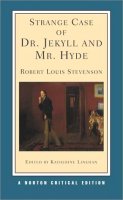Assignment One: The Text of Strange Case of Dr. Jekyll and Mr. Hyde, pp. 1-32. Search JSTOR and other sources for articles for your major paper. Search JSTOR and other sources for articles for your major paper.
1. Why does Stevenson have the pawnbroker suggest a mirror as a present? How is the idea of a mirror developed in the story? 2. What is the effect/purpose of the paragraph that begins on page 110 and ends on 111, the paragraph about the screen with pictures? Where else are pictures important in the story? 3. Why are there so many references to sounds in the story? 4. What is Markheim's motive for the crime? 5. Who visits Markheim when he is upstairs? (Be prepared to explain your answer.) 6. Is Markheim's justification of his crime (page 115) valid? Why? 7. What is the point of the visitor's speech that begins with "I do not say so..." (p. 116)? 8. Which of the conflicts on our list is most relevant to this story? Why? 9. Is the ending of this story believable? Why or Why not? 10. What, in your view, is the theme of this story? (Support it.) Search JSTOR and other sources for articles for your major paper.
Walkowitz, cartoon from Punch, and Houghton, pp. 141-149 -- which critical approach best describes these selections? In two or three sentences, explain how these selections are relevant today. Charles King, "Theme and Variations," pp. 157-163. -- In a sentence or two, summarize this selection, and then, in another sentence or two, explain what you found most interesting in it. G. K. Chesterton and Vladimir Nabokov, pp. 183-188. In one sentence for each, explain what you consider to be the main point of these two selections. Search JSTOR and other sources for articles for your major paper.
Katherine Linehan, pp. 204-213. Summarize this essay in a short paragraph and then, in another short paragraph, explain why you agree or disagree with her. Search JSTOR and other sources for articles for your major paper. Tentative Works Cited for MP # 2 is due. Skip Additional Suggestions for Paper Topics 1. What does Strange Case suggest about the duality of human
nature?
Bonus Point Options:
A. For Five points - Compare Strange Case to Edgar Allan Poe's
"William Wilson"
These options are no more difficult than other suggestions for topics. The bonus points are offered because the reading of "William Wilson" or The Double will require more time and effort. In order to earn the bonus points, papers must demonstrate that you have read the work to which you are comparing Strange Case. To demonstrate this, the paper should include numerous short quotations both to Strange Case and to the work being compared to it. Note that the paper must also fulfill the requirements on the grading sheets, including the use of secondary sources. Suggestions for brainstorming:
|
